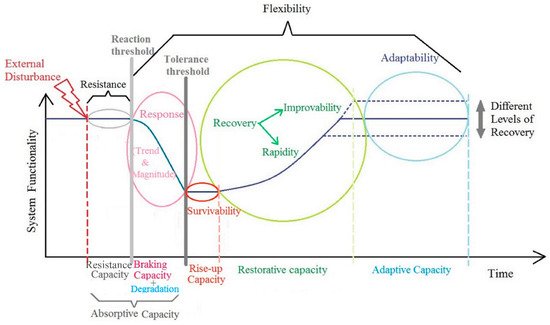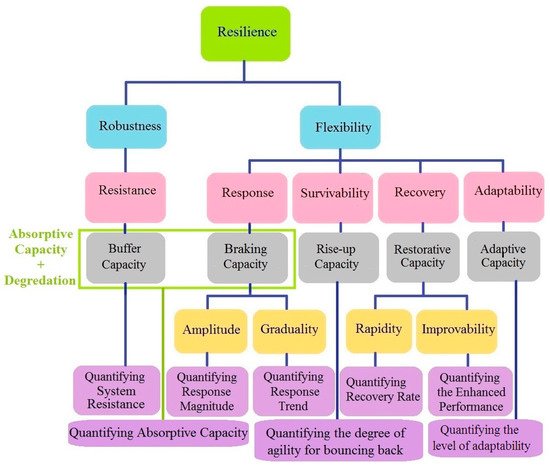Various approaches to quantifying resilience have sparked debate in past years. This study measures the social and hydraulic resilience of an Urban Drainage System (UDS) using two methodologies, i.e., a proposed index-based framework and a parametric-based Multi-Criteria Decision Making (MCDM) method. The former positions flexibility as a key property of the resilience concept, and after quantifying four characteristics of a flexible system, measures the flood resilience based on quantifying the two resilience components, i.e., flexibility and resistance; while. The latter calculates the resilience through a linear combination of the actual values and relative weights for different UDS sub-characteristics which best describe the resiliency of the system.
1. Introduction
Building resilience into urban critical infrastructures is essential to have the urban daily functions continue as normal in the face of various disasters. Measuring resilience is a crucial step in gaining such an achievement. It is known that resilience is the ability of a system to revert to its previous state after being disturbed by a perturbation. Flexibility, on the other hand, is sometimes used in the same meaning as resilience [
1], which means there is a lack of focus on this concept as a different notion from resilience. Although- in some of the past studies and particularly in the field of psychology- flexibility has been mentioned as a close concept to resilience and related to it, it has not been characterized as an element under resilience structure. In other words, the concept of flexibility has not been well placed within the resilience mechanism. Only a few studies have focused on the notion of flexibility in detail, while the quantification of this concept has been missing in most cases. Some studies believe that a flexible system has the main capabilities of resilience.
However, most studies agree that robustness (as an attribute of the resistance concept) could be at least a part of resilience. Restemeyer et al. [
2] argue that resistance can be one important aspect of resilience. In line with this, Tempels and Hartmann [
3] believe that prioritizing resistance or flexibility over each other does not seem to be true and state that there should be a balanced approach towards flexibility and robustness [
4]. Asokan et al. [
5] defined flexibility as the representative of two main resilience parameters, i.e., robustness and transformation, but not as a factor inside the resilience configuration. In the current study, we have a new definition of resilience based on system flexibility. In the proposed definition, flexibility is nearly the same as resilience, excluding one metric (the robustness), which is the only term that resilience has more than flexibility. In fact, flexibility is most of the resilience concept. Such an approach seems to agree with the idea represented by Husdal [
6], who believes robustness and flexibility are essential tools for handling risks and uncertainties.
It could be said that despite the frequent use of the term flexibility, very little work has been accomplished to quantify this term, especially regarding the urban drainage system. Some studies focused on flexibility measurements concerning the other meanings of flexibility suitable for the other types of systems and provided with the quantification methods are not necessarily applicable to the UDS. For example, Stinner et al. [
7] proposed a quantification method of flexibility specific to the Building Energy Systems with Heat Pumps. Fletcher [
8] addressed flexibility in Water Supply Infrastructure Planning. However, the purpose was not to quantify the flexibility or resilience of the system. Sidqi et al. [
9] defined flexibility in the household as the capacity to increase, decrease, or shift the consumption of domestic appliances over time and quantified the consumed power in 194 households, and computed the share of both heating needs, i.e., space heating and hot water heating.
2. Definition of Resilience Based on “Robustness” and “Flexibility”
Resilience is defined as the system’s capacity to cope, adapt, and improve in response to both chronic stresses and acute shocks applied to it [
13,
14]. Before explaining how such a definition could be expressed based on two elements of “robustness” and “flexibility”, we had better have a comparison between the two components.
Robustness points to the ability of a system to “stay on course” and absorb unforeseen and uncertain future disturbances [
6]. A Robust system accommodates the perturbations and resists the disturbance so that it continues its pre-defined path without functional degradation. This is why flexibility means the capacity to accommodate unforeseen disturbances “by changing tracks and being open to temporarily deviate from the initial course to reach the desired goal” [
6]. A flexible system can gracefully degrade while exposed to a disturbance and restructure itself rapidly with an adaptive approach and by learning from past experiences. It seems that concerning the flexibility concept, what is important is the final goal without being hurt, no matter how the path has to be paced during a disaster, whereas robustness focuses on the capacity of the system to endure such changes [
15]. Totally, as Husdal [
6] states, “robustness reduces uncertainty and flexibility adapts to it”.
According to resilience’s general definition and descriptions of system robustness and flexibility presented above, the resilience of a system is highly dependent on these two concepts. Thus, measuring the system resilience requires quantifying the subset components, i.e., robustness and flexibility. Walker et al. [
16] define flexibility as “dynamic robustness”, which enables a plan to change in response to changing conditions over time.
A literature review indicates that flexibility has been viewed from two different angles based on where on the system functionality curve (
Figure 1) it will be considered: in the response phase or within the recovery phase and after that. In the first meaning, flexibility refers to the degree of proportionality in response to distribution and means not having an abrupt failure due to a sudden shock. In this meaning, a system is flexible if the applied perturbation is mostly absorbed, and therefore, consequences or damages emerge little by little. Based on such a definition, with a flexible system, there is enough time to mobilize the equipment and resources and cope with the impacts of the shock while the damages are not too large. This meaning of flexibility has been expressed in the current study as “braking capacity”, which has a close relationship with the notion of “graduality” introduced by De Bruijn [
17]. Graduality refers to the increase in damage with increased disturbance magnitude [
18]. This is why braking capacity represents the trend of system degradation with time.

Figure 1. The system behavior in response to a disturbance.
In the second meaning, flexibility is related to uncertainties in future conditions and, thus, uncertainties in estimations for future planning. In this meaning, flexibility refers to the willingness and ability to adopt alternative strategies in response to changing circumstances or sudden crises [
13]. In other words, despite the primary estimations for future conditions and planned implementations, a flexible system could still be stable and welcome such unforeseen changes. Heggarty et al. [
19] considered this meaning of flexibility for power systems and defined it as “the ability to cope with variability and uncertainty in demand”. This translation of flexibility has been referred to as “adaptive capacity” in the current study.
However, some other descriptions of flexibility can be found in the literature covering both above-mentioned definitions, according to which flexibility is described as system change, evolution, and adaptation in response to changing circumstances. This definition matches the most to what the current study means by flexibility. The current definition encompasses a wide range of system behavior in the face of an external perturbation and involves both the meanings pointed out above. This study believes that flexibility is composed of four metrics of response, survivability, recovery, and adaptability, and defines flexibility as the ability of a disturbed system to have (1) a soft response (i.e., with a small response-magnitude and a graceful degradation), (2) a short stay in the failure mode and ability to immediate rise-up, (3) a rapid restoration to an acceptable level of performance or ideally, an improved one, and (4) adapt to the new conditions after changing the surrounding environment or the system condition.
3. System Behavior in Response to a Disturbance
Before quantifying the resilience components, it is necessary to explain the system performance and behavior as well as the critical thresholds in response to an external perturbation. The behavior of a disturbed system vs. time has been presented in
Figure 1. Three types of critical thresholds can be recognized in such a performance curve. The first one is the “reaction threshold”, which is located at the end of the resistance domain. After that, the system is no longer able to endure the applied perturbation and thus, starts responding to it and degrades. Concerning urban flooding, the reaction threshold occurs when we have the largest load on the system (i.e., the largest amount of extreme rainfall), which is not supposed to create flooding [
20,
21,
22]. At the end of the response process, when the system performance reaches its minimum level possible, the “tolerance threshold” occurs, which means a threshold where the system cannot bear the disturbance anymore. This is why before this threshold, a part of the disturbance could be absorbed by the system alongside the performance degradation. In fact, the “tolerance threshold” is located before the maximum failure of the system. Apart from the two mentioned thresholds, a third could be identified in the system behavior curve, which is called the “non-recovery” threshold and is not determined in
Figure 1 since it occurs only in certain conditions. The “non-recovery” threshold happens when the system is no longer able to return to its previous status and enters a new attraction basin and new stability domain. A regime change happens in system performance and status, which may occur when the failure time duration and system stagnation is too long. If the magnitude of the system response to a disturbance is so large that it causes the system to spend a long time at its minimum level of performance, or if the disturbance magnitude is too large and goes beyond certain limits, the system is no longer able to return to its previous stability status, which is where the “non-recovery” threshold makes sense [
23,
24].
As shown in Figure 1, the system behavior curve experiences five different stages when exposed to an external disturbance (i.e., resistance, response, rise-up, recovery, and adaptability phases). Quantifying these phases means measuring the components of a disaster cycle, from resistance against a disaster to recovery, mitigation, and preparedness for future similar hazards. Figure 2 demonstrates the components of system resilience in the proposed framework.
Figure 2. The proposed framework for quantifying system resiliency to disasters.
This entry is adapted from the peer-reviewed paper 10.3390/w14132007


